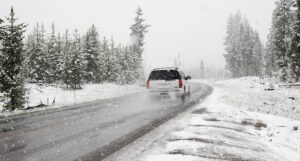 Winter weather brings snow, freezing rain, ice, bitterly cold temperatures, and sometimes hazardous road conditions. While the holidays are over, many of us still commute daily to work and school, and are exposed to changing weather conditions. Below are several tips to ensure that everyone makes it to their destinations safely. Remember, even if the snow is melting, that can lead to slippery conditions. And if the temperature still drops below freezing at night, be careful of icy conditions in the morning.
Winter weather brings snow, freezing rain, ice, bitterly cold temperatures, and sometimes hazardous road conditions. While the holidays are over, many of us still commute daily to work and school, and are exposed to changing weather conditions. Below are several tips to ensure that everyone makes it to their destinations safely. Remember, even if the snow is melting, that can lead to slippery conditions. And if the temperature still drops below freezing at night, be careful of icy conditions in the morning.
- Check your tire tread and pressure. Good tire tread and properly inflated tires are essential to staying in control on slippery roads. You can check your tire’s tread with a quarter. Stick a quarter in the tread. If the tread goes above Washington’s head than your tread depth is 4/32″. This is an appropriate level for winter roads. If your tread is less, you should replace your tires. Snow tires are also a great idea when preparing for driving in winter conditions.
- Stay at least one vehicle length away from the vehicle in front of you for every 10 miles per hour you are driving. If it is dark out you should add another 5 miles on top of that. The more space between you and the vehicle in front of you, the more likely you will avoid an accident.
- Do not use your brakes going around a turn; this is a sure way to start skidding in bad winter driving conditions. Brake before you turn in order to avoid skidding. If you do find yourself in a skid, follow the skid until you feel traction again and return your vehicle to its original direction. Remember to release your brakes when you start skidding because braking will prolong the skid.
- Bring rock salt or sand with you at all times. If you get stuck, sprinkle the sand or salt around your tires and it will help you gain traction.
- The worst type of ice is black ice. Remember that black ice is hard to see and many times it is unnoticeable. If the road looks wet or darker than normal you are probably headed for black ice so slow down before you reach it. Use caution and drive slowly if you suspect black ice on the road.
- Snow and ice on your windshield and windows is hazardous in winter weather conditions. Keep winter windshield washer fluid filled and a window scraper in your vehicle. Be sure that your windshield wipers are in good condition for winter driving.
- Fill up your gas tank. A fuller gas tank prevents your vehicle’s gas-line from freezing. Having extra gas will allow you to run the heat longer if you get stuck or are in an accident.